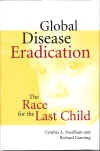 |
Global Disease Eradication: The Race for the Last Child
| Home | About Us | Vision | Collaborating Partners | Strategic Consulting | Work in Progress | Sponsors and Funders | Contact Us | |
About
the Book
Global Disease Eradication is in
part about the smallpox victory and the end game that followed, but it is also a
look into the debate surrounding global disease eradication, a goal that many in
the world health community see as the ultimate achievement of public health.
The
authors present the history of three separate campaigns to eradicate a major
infectious disease worldwide. The first, against malaria, though undertaken with
ambition and optimism, ultimately failed: at the beginning of the 21st century,
malaria threatens the health of over 2,400 million people worldwide. In
contrast, the campaign against smallpox succeeded for a wide variety of reasons.
Now public health workers are within a hair's breadth of eradicating polio --
the third campaign -- but tremendous uncertainties still surround the effort.
Whether
these monumental global campaigns should be undertaken remains an open question.
What is the value of global disease eradication if, as with smallpox, it
ultimately leaves the world's population susceptible to accidental or
intentional reintroduction of the disease? What are the costs of an eradication
program, both direct and indirect, as resources are funneled into a single
purpose at the cost of other priorities? What are the challenges involved in
actually stopping a disease in its tracks?
Needham and Canning contribute a clear evaluation of the social, political, scientific, and economic considerations, both for the three specific campaigns described and for all future efforts toward protecting every child worldwide for deadly infectious diseases.
Global Disease Eradication: Race for the Last Child is available through www.amazon.com, www.asmpress.org, and www.bearpondbooks.com.
Eradication:
a Prologue
Malaria
and the Magic Bullet
| Outbreak | |
| Two Children | |
| Swamps, Farms, and Bad Air | |
| Escalating Pressure | |
| Learning from the Past: Hard Lessons, Hard Work | |
| Biology Plays Its Hand | |
| Social Issues Loom Large | |
| Fatal Inflexibility: One Plan To Fit All | |
| The Price of Failure | |
| Forward to the Present | |
| Magic Bullets | |
| Malaria, Man, and Mosquito: The Biologic Perspective |
Smallpox: the Right Disease, the Right Time
| Fading Scars | |
| From Golden Needles to Vaccine | |
| Moving toward Control | |
| Thinking about Eradication | |
| Commitment, Evolution, Success | |
| Smallpox Zero | |
| The Smallpox Dividend | |
| An Incomplete Life: The Biologic Perspective |
Polio: the Rise and Fall of a Disease
| The Countdown | |
| Biologic Realities | |
| The Invisible Disease | |
| The Clearing Picture | |
| President Roosevelt's Other War | |
| The Needs of the World | |
| Brazil's Attack | |
| Coming to America | |
| Going Global | |
| Measures of Success-or Failure | |
| The End Game | |
| Another Virus, Another Vaccine: The Biologic Perspective |
The
Future for Global Disease Eradication
| Biologic Feasibility | |
| Financial Resources | |
| Political Will | |
| Social Benefit | |
| The Next Campaign |
Epilogue:
Voices from the Eradication Campaigns
| Christopher Plowe and Abdoulaye Djimde: Malaria Warriors | |
| Donald Ainslie Henderson: Politics and Public Health | |
| William Foege: Legacy of the Smallpox Campaign | |
| Sharon Bloom: When Politics Are Local | |
| Phillip Spradling: from Primary Care to the Mountains of Nepal | |
| Kathy Kohler: Fulfilling a Dream | |
| Alice Pope: a Passion for People | |
| Duane Kilgus: from Desk to Desert | |
| Virginia Swezy: a Champion in the Final Leg of the Race | |
| Steve Stewart: Roads and Rivers | |
| Fabio Leviano: Opening Pandora's Box | |
| Donald Hopkins: the Blowing of a Certain Trumpet | |
| Walter Dowdle: the Leader People Barely Know Exists | |
| Steve Cochi: Turning Dreams into Reality | |
| The World Health Organization |